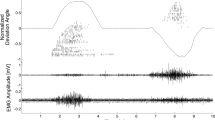Abstract
In this study, human arm movement was re-constructed from electromyography (EMG) signals using a forward dynamics model acquired by an artificial neural network within a modular architecture. Dynamic joint torques at the elbow and shoulder were estimated for movements in the horizontal plane from the surface EMG signals of 10 flexor and extensor muscles. Using only the initial conditions of the arm and the EMG time course as input, the network reliably reconstructed a variety of movement trajectories. The results demonstrate that posture maintenance and multijoint movements, entailing complex via-point specification and co-contraction of muscles, can be accurately computed from multiple surface EMG signals. In addition to the model's empirical uses, such as calculation of arm stiffness during motion, it allows evaluation of hypothesized computational mechanisms of the central nervous system such as virtual trajectory control and optimal trajectory planning.
Similar content being viewed by others
References
Akazawa K, Takizawa H, Hayashi Y, Fujii K (1988) Development of control system and myoelectric signal processor for bio-mimetic prosthetic hand. Biomechanism 9:43–53
Basmajian JV, De Luca CJ (1985) Muscles alive. Williams & Wilkins, Baltimore
Bawa P, Stein R (1976) Frequency response of human soleus muscle. J Neurophysiol 39:788–793
Bennett D (1993) Electromyographic responses to constant position errors imposed during voluntary elbow joint movement in human. Exp Brain Res 95:499–508
Brown S, Cooke J (1990) Movement related phasic muscle activation. I. Changes with temporal profile of movement. J Neurophysiol 63:455–464
Clancy EA, Hogan N (1991) Estimation of joint torque from the surface EMG. Annual International Conference of the IEEE Engineering in Medicine and Biology Society 13:0877–0878
Dornay M, Uno Y, Kawato M, Suzuki R (1992) Simulation of optimal movements using the minimum-muscle tension-change model. In: Moody JM, Hanson SJ, Lippmann RP (eds) Advances in neural information processing systems 4. Morgan Kaufmann, San Mateo, pp 627–634
Gottlieb GL, Corcos DM, Agarwal GC (1989) Organizing principles for single-joint movements. I. A speed-insensitive strategy. J Neurophysiol 62:342–357
Jacobs R, Jordan M (1991) A competitive modular connectionist architecture. In: Moody JM, Hanson SJ, Lippmann RP (eds) Advances in neural information processing systems 3. Morgan Kaufmann, San Mateo, pp 767–773
Karst GM, Hasan Z (1991) Timing and magnitude of electromyographic activity for two-joint arm movements in different directions. J Neurophysiol 66:1594–1604
Katayama M, Kawato M (1993) Virtual trajectory and stiffness ellipse during multijoint arm movement predicted by neural inverse models. Biol Cybern 69:353–362
Kawato M (1992) Optimization and learning in neural networks for formation and control of coordinated movement. In: Meyer D, Kornblum S (eds) Attention and performance, XIV. MIT Press, Cambridge, Mass.
Koike Y, Kawato M (1993) Virtual trajectories predicted from surface EMG signals. Soc Neurosci Abstr 19:543
Koike Y, Kawato M (1994a) Estimation of arm posture in 3D-space from surface EMG signals using a neural network model. IEICE Trans Fundamentals D-II(4):368–375
Koike Y, Kawato M (1994b) Trajectory formation from surface EMG signals using a neural network model. IEICE Trans (D-II) J77(1):193–203 (in Japanese)
Koike Y, Honda K, Hirayama M, Gomi H, Bateson E-V, Kawato M (1992) Dynamical model of arm using physiological data. Tech Rep IEICE NC91-146, pp107–114 (in Japanese)
Koike Y, Honda K, Hirayama M, Gomi H, Bateson E-V, Kawato M (1993) Estimation of isometric torques from surface electromyography using a neural network model. IEICE Trans (D-II) (6):1270–1279 (in Japanese)
Mannard A, Stein R (1973) Determination of the frequency response of isometric soleus muscle in the cat using random nerve stimulation. J Physiol 229:275–296
Mori D, Tsuji T, Ito K (1992) Motion discrimination method from EMG signals using statistically structured neural networks. Tech Rep IEICE NC91-143, pp 83–90 (in Japanese)
Nowlan S, Hinton G (1991) Evaluation of adaptive mixtures of competing experts. In: Moody JM, Hanson SJ, Lippmann RP (eds) Advances in neural information processing systems 3. Morgan Kaufmann, San Mateo, pp 774–780
Ochiai K, Usui S (1994) Kick-out learning algorithm to reduce the oscillation of weights. Neural Networks 7:797–807
Rack P, Westbury D (1969) The effects of length and stimulus rate on tension in the isometric cat soleus muscle. J Physiol 217:419–444
Rumelhart D, Hinton G, Williams R (1986) Learning representations by backpropagating errors. Nature 323:533–536
Soechting J, Roberts W (1975) Transfer characteristics between EMG activity and muscle tension under isometric conditions in man. J Physiol 70:779–793
Suzuki R, Suematsu T (1969) Pattern recognition of multi-channel myoelectric signals by learning method. Jpn J Med Electron Biol Eng 7:47–48 (in Japanese)
Uno Y, Kawato M, Suzuki R (1989a) Formation and control of optimal trajectory in human multijoint arm movement: minimum torque-change model. Biol Cybern 61:89–101
Uno Y, Suzuki R, Kawato M (1989b) Minimum-muscle-tension-change model which reproduces human arm movement. Proceedings of the 4th Symposium on Biological and Physiological Engineering, pp 299–302 (in Japanese)
Wada Y, Kawato M (1992) A new information criterion combined with cross-validation method to estimate generalization capability. Syst Comput Jpn 23:92–104
Winters JM (1990) Hill-based muscle models: a systems engineering perspective. In: Winters JM, Woo SL-Y (eds) Multiple muscle systems. Springer Berlin Heidelberg New York, pp 69–93
Wood J, Meek S, Jacobsen S (1989) Quantitation of human shoulder anatomy for prosthetic arm control. II. Anatomy matrices. J Biomech 22:309–325
Author information
Authors and Affiliations
Rights and permissions
About this article
Cite this article
Koike, Y., Kawato, M. Estimation of dynamic joint torques and trajectory formation from surface electromyography signals using a neural network model. Biol. Cybern. 73, 291–300 (1995). https://doi.org/10.1007/BF00199465
Received:
Accepted:
Issue Date:
DOI: https://doi.org/10.1007/BF00199465




